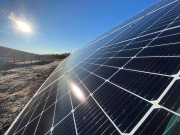In just over ten years' time, it could be cheaper to put a solar panel on your roof than to buy electricity from the grid. Not only that, but solar power could produce enough electricity to meet one-quarter of global demand by 2050, according to a new road map published by the International Energy Agency (IEA).
But it won't happen by accident.
 The federal building in Yellowknife produces electricity from integrated solar PV panels (dark blue rows pictured above).These predictions are important, because they recognize the potential for solar to become a major supply source, as opposed to the role people usually see it playing, as a "nice to have" but boutique (expensive and small-scale) option. Who is making these predictions also matters. The research is not coming from an environmental group or even a solar industry group, rather from the Paris-based IEA — an energy advisory group, founded during the OPEC oil crisis of 1973-74 to prevent oil supply shortages among its 28 member countries (including Canada, the U.S., Australia, Japan and most of Europe). While the Agency has moved beyond a strict focus on oil in recent years, it is by no means dedicated to promoting alternative power.
The federal building in Yellowknife produces electricity from integrated solar PV panels (dark blue rows pictured above).These predictions are important, because they recognize the potential for solar to become a major supply source, as opposed to the role people usually see it playing, as a "nice to have" but boutique (expensive and small-scale) option. Who is making these predictions also matters. The research is not coming from an environmental group or even a solar industry group, rather from the Paris-based IEA — an energy advisory group, founded during the OPEC oil crisis of 1973-74 to prevent oil supply shortages among its 28 member countries (including Canada, the U.S., Australia, Japan and most of Europe). While the Agency has moved beyond a strict focus on oil in recent years, it is by no means dedicated to promoting alternative power.
The IEA's announcement shows just how much the technology and market for solar energy production has developed in the past few years. In fact, these numbers even took me by surprise. In 2008, I co-authored a study looking at the potential for renewable energy to replace coal power in Alberta. The report, Greening the Grid, found that Alberta could shift from a grid consisting of almost 70 per cent coal power to close to 70 per cent renewable and clean power in just 20 years. When we did this study, we constrained ourselves to only using existing technology and prices — and based on 2008 prices, solar power was limited to playing a very minor role in this potential transition.
 While those were appropriate assumptions to ensure our research was conservative, it shows just how quickly things can change for the better in the renewable energy world, and I will be the first to admit we sold solar short.
While those were appropriate assumptions to ensure our research was conservative, it shows just how quickly things can change for the better in the renewable energy world, and I will be the first to admit we sold solar short.
Today, the IEA's predictions show the potential is growing for solar electricity to replace fossil fuels in providing both peak and in base load. The sun's rays can produce electricity two ways, through solar photovoltaics (PV) and concentrating solar power (CSP). PV cells convert sunlight directly into electricity, an attribute that is very useful for providing peak power particularly in jurisdictions that use air conditioners. Concentrating solar projects use mirrors or lenses to reflect beams of sunlight onto heat-conducting liquids, which can then be used to generate power immediately, or stored to generate power even when the sun is not shining. CSP systems are most effective for utility-scale generation for transmission. Combined, the IEA estimates the two technologies could generate 9,000 Terawatt hours of power in 2050, according to the IEA's research — that's enough electricity to meet all of Canada's current electricity needs 16 times over.
At the release in Spain last week of two "roadmaps" outlining the technological developments required to meet this goal, the head of the IEA pointed to an additional benefit of switching to solar.
"The combination of solar photovoltaics and concentrating solar power offers considerable prospects for enhancing energy security while reducing energy-related CO2 emissions by almost six billion tonnes per year by 2050," said Nobuo Tanaka, Executive Director of the IEA. (Cutting six billion tones of CO2 emissions is roughly equivalent to taking one billion cars off the road.)
But there's a catch.
"This decade is crucial for effective policies to enable the development of solar electricity," Tanaka explained. "Long-term oriented, predictable solar-specific incentives are needed to sustain early deployment and bring both technologies to competitiveness in the most suitable locations and times."
In other words, governments need to support the development of the solar industry by establishing (or in some cases continuing) clear market incentives and enabling regulations to provide stability and direction for investments over the long term. The IEA cautions that incentives will need to evolve over time, both to encourage innovation and to support the refining of current technologies. No other policy does this better than Feed-In Tariffs.
Under effective deployment policies, as well as stable research and development support, the IEA predicts that the retail price of electricity generated through residential and commercial use of solar PV could equal that of traditional electricity within the next decade in many regions.
 At this concentrated solar power site, mirrors redirect sunlight to a tower, where the rays heat liquid to produce electricityNorth America is set to become the largest producer of CSP electricity (especially in the American desert, where large-scale CSP projects are already underway), though there is also strong potential in North Africa and India. Under the right policies, the IEA says that, in the sunniest areas, concentrated solar will be able to compete with other forms of electricity on the market by 2020 for peak and mid-peak loads. It's expected to compete with base load power by 2030 or sooner.
At this concentrated solar power site, mirrors redirect sunlight to a tower, where the rays heat liquid to produce electricityNorth America is set to become the largest producer of CSP electricity (especially in the American desert, where large-scale CSP projects are already underway), though there is also strong potential in North Africa and India. Under the right policies, the IEA says that, in the sunniest areas, concentrated solar will be able to compete with other forms of electricity on the market by 2020 for peak and mid-peak loads. It's expected to compete with base load power by 2030 or sooner.
Of course, achieving this will require further innovation, long-term planning and proper management. But the first step is for governments to recognize the potential that exists in solar power generation, and to commit to making the transition from high-polluting sources such as coal and oil, by supporting the development and deployment of solar technologies and providing stable market conditions for investment.
The Ontario government is leading the way in North America with its new Green Energy and Green Economy Act, which offers Feed-In Tariffs for solar PV systems, among other renewable technologies. This policy, barely a year old, has already given rise to more than 650 Megawatts of solar PV projects, while manufacturers are rushing to the province to set up shop.
The rest of Canada doesn't have to sit back and watch. The IEA has made it clear that solar power can be a major source of clean power coast to coast and beyond our borders. Now it's up to our governments to decide if they want to be a part of this boom, or watch and learn while others take the lead.
Tim Weis will be speaking at the first western conference of the Canadian Solar Industries Association on May 26 in Calgary, as part of a panel discussing where renewable and solar power generation fit into the western landscape.










